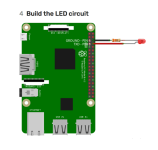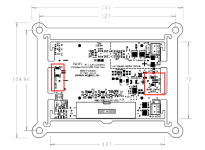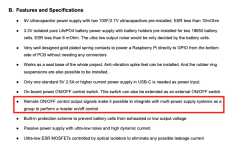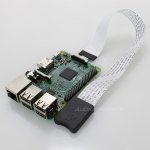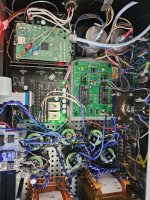I only use the push button for safe shutdown of Raspberry Pi, for startup I use the trigger of the Ian PurePi Ultracapacitor power supply.Hi @gizmo3,
I used to manage the push on/off button with GPIO Button Volumio plugin. But I guess your solution is different. Would you share or tell where I can find a way ?
I also use the volumio gpio plugin (I use gpio 4 with a momentary push button) if you use gpio 3 I think you can start and shut down the Pi.
for just shutdown you could also place the below line in the boot/config.txt with a gpio pin of your choice or what is not in use.
dtoverlay=gpio-shutdown,gpio_pin=4,active_low=1,gpio_pull=up=gpio-shutdown
for the LED I use gpio 14 TXD with a resistor of 260 ohm, you also need to add the line enable_uart=1 to the boot/config.txt file so that the LED turns on and off when you use the power on/off button.
Attachments
Last edited:
Hi @gizmo3 , so it's like I have done. Thx. I used GPIO 3 to start and stop. that's right. The ring LED is attached to the momentary button (GPIO17). Right now I use PurePi trigger too, during prototyping. But with the future enclosure, it will be not available. PupePi manual talks about external module, but I don't know where to find some (I haven't seen nothing like this on Ian's website). Any ideas ?
I use the external switch (j5) in combination with a relay.
When I turn on the main switch it is triggered by the relay.
you probably mean this on/off control j9, I don't use it myself, but I think I can also just use it as a trigger by means of a power supply, I don't know exactly how this works.
When I turn on the main switch it is triggered by the relay.
you probably mean this on/off control j9, I don't use it myself, but I think I can also just use it as a trigger by means of a power supply, I don't know exactly how this works.
Attachments
Last edited:
Hi forum members.
I'm new here, and am hoping someone will offer an opinion. I am building my second ever rpi dac streamer, and am trying to see if I can hear difference with the first. So I've been extravagant.
This is really all Ian Canada stuff. First time was Allo. The dual mono dac board for this build has the same chip I think as my Katana USBridge Signature. This time I've bought the Fifopi Q7 and the pair of RFX ocox's.
My question is on power supplies. This is definitely a bigger project for me. I have some of the Linear pi boards, a Sellerz bipolar lpsu for the output board on the stack, and an extra Allo Shanti I want to make use of.
I've read on this thread, and definitely in Ian Canada's marketing how the super capacitor packs are, well super. I have room and the means for two only of these UcPure psu's, and have in mind to power the dac board and the Fifo Q7 that way. I'd use the Shanti for the Uber clocks.
However this scheme is because I have toroids already for into UcPure, have lpsu's for rpi4 and spdif board,and it happens that the dual output from the Shanti are a match for those new clocks. This way I use what I have already bought. I don't know if it might not be better to reorganize.
If I were to feed the RFX clocks from UcPure,
1) could one UcPure feed both clocks bridged? I thought both stay on (warm) although it's preferable to mute the not in use clock. In case each clock needs its own super capacitor pack, that would mean both the dac and the Fifo Q7 would have to get LinearPi supplies.
2) In case one UcPure is sufficient for both clocks bridged, would dac or Fifo Q7 be better match for my second UcPure?
It comes down to whether people who know more than me think there's a problem powering the clocks with the Shanti. My lay understanding is it is a super quiet lpsu. Being 5 V, it would not work for Fifo or dac. Being ready made is a plus given all the separate psu's I need. Being separate, it would be simple to just leave it on constantly - which I think the clocks like.
Thank for reading, and for any thoughts you might have.
I'm new here, and am hoping someone will offer an opinion. I am building my second ever rpi dac streamer, and am trying to see if I can hear difference with the first. So I've been extravagant.
This is really all Ian Canada stuff. First time was Allo. The dual mono dac board for this build has the same chip I think as my Katana USBridge Signature. This time I've bought the Fifopi Q7 and the pair of RFX ocox's.
My question is on power supplies. This is definitely a bigger project for me. I have some of the Linear pi boards, a Sellerz bipolar lpsu for the output board on the stack, and an extra Allo Shanti I want to make use of.
I've read on this thread, and definitely in Ian Canada's marketing how the super capacitor packs are, well super. I have room and the means for two only of these UcPure psu's, and have in mind to power the dac board and the Fifo Q7 that way. I'd use the Shanti for the Uber clocks.
However this scheme is because I have toroids already for into UcPure, have lpsu's for rpi4 and spdif board,and it happens that the dual output from the Shanti are a match for those new clocks. This way I use what I have already bought. I don't know if it might not be better to reorganize.
If I were to feed the RFX clocks from UcPure,
1) could one UcPure feed both clocks bridged? I thought both stay on (warm) although it's preferable to mute the not in use clock. In case each clock needs its own super capacitor pack, that would mean both the dac and the Fifo Q7 would have to get LinearPi supplies.
2) In case one UcPure is sufficient for both clocks bridged, would dac or Fifo Q7 be better match for my second UcPure?
It comes down to whether people who know more than me think there's a problem powering the clocks with the Shanti. My lay understanding is it is a super quiet lpsu. Being 5 V, it would not work for Fifo or dac. Being ready made is a plus given all the separate psu's I need. Being separate, it would be simple to just leave it on constantly - which I think the clocks like.
Thank for reading, and for any thoughts you might have.
Please keep in mind that if you use a micro SD card extender, the micro SD card extender will get in the way of the J9 output control signal/trigger and therefore cannot be used to control other modules.Ok ! I see now 😉thank you !
Attachments
Hello,
Another new kid on the block
It seems that people have little understanding about legislation related to consumers and commercial enterprises in the EU. Just like with tenants and big real estate owners the one with the least power is the most protected. The EU even offers consumers legal assistance in case a company is doing things the wrong way.
Wether you buy a fully assembled product, a stuffed board or just a power plug. All of them are legally seen as products. If you buy an oil filter for your car that you intend to install yourself you wont have any right when the thing is not working because you decided to do it yourself.
Greetings Eduard

Another new kid on the block
It seems that people have little understanding about legislation related to consumers and commercial enterprises in the EU. Just like with tenants and big real estate owners the one with the least power is the most protected. The EU even offers consumers legal assistance in case a company is doing things the wrong way.
Wether you buy a fully assembled product, a stuffed board or just a power plug. All of them are legally seen as products. If you buy an oil filter for your car that you intend to install yourself you wont have any right when the thing is not working because you decided to do it yourself.
Greetings Eduard
Marcin,I observe a particular phenomenon and want to ask if any of you observe the same:
My DAC stack is:
ReceiverPI DDC
FiFoPi Q7 with SC-Pure clocks powered by UcPure
Dual Mono DAC HAT MKII
OPA861 I/V board powered by LinearPI + UcConditioner
The FiFoPI Q7 is connected to the continuous power from UcPure so SC-Pure clocks are powered all the time. The rest of the power supply is turned on when I need it.
What I observe is that initially, after switching on, the whole stack sounds worse compared to how it sounds after it has "warmed up". After about 30-60 minutes, it starts to sound right.
Does only one else experience something similar? What could the reason be?
Marcin
I didn't see where anyone else answered your question.
I observe the same in my IanCanada DAC stack... & honestly in every other powered audio gear I use.
Most need about 30 minutes or a little longer to sound their best.
A few pieces (Hypex NC400 amps most notably) took longer, those amps took 3 hours or so to sound their best.
I first heard this effect back in the early 1980s with a system I would charitably now call 'barely mid-fi'. One Saturday I spent several hours rearranging the gear. When I powered it back on I thought I had broken something or hooked it up wrong. I went through the entire setup checking connections to ensure I'd put it back together ok... & by the time I finished, it was sounding better. Then, after about an hour, it was back to what I remembered.
I've heard various explanations for this, some of it is likely different electronic components reaching thermal equilibrium. I am not sure that explains it all, but I clearly hear it every time I've powered up parts or all of a system after they have been down for at least an hour or so.
Mostly I leave my gear powered & running now. The exceptions are my amps which have a nice standby mode (partly to preserve tube life) & my Ian DAC stack where I am currently powering the OPA861 I/V stage from the 2 3.3V rails of Ian's larger battery supply board.
Of course, this is in my setup & to my ears. YMMV.
Greg in Mississippi
Thank you for taking the time to respond @Greg Stewart. I had a suspicion that the cause could be what you describe. Since no one replied I started to question my sanity ;-)
After a long hiatus from DIY audio I'm starting to look into what the latest a greatest goodies out there are. This thread has my head spinning...
More than 10 years ago I built a decked out TDA1541a based dac, with 10 power supplies, tube output stage, and using a squeezebox as a built-in transport. I'm considering upgrading this to the latest technology. Two questions:
Do you guys reckon its worth while to upgrade my setup, replacing the squeezebox with a RPI4 and adding Fifo etc to feed the old TDA1541a ? This chip as you know has limitations...
Has it been done? I couldnt find much via the search function
More than 10 years ago I built a decked out TDA1541a based dac, with 10 power supplies, tube output stage, and using a squeezebox as a built-in transport. I'm considering upgrading this to the latest technology. Two questions:
Do you guys reckon its worth while to upgrade my setup, replacing the squeezebox with a RPI4 and adding Fifo etc to feed the old TDA1541a ? This chip as you know has limitations...
Has it been done? I couldnt find much via the search function
@studiostevus
I use a similar TDA1541a DAC with triode output buffer fed by FIFOPi, great clocks and an PCM2I2S board. I think there are no limits to the 1541A's ability to produce good sound. The beauty of iancanada building blocks is the flexibility to use any clock and any level of power supply. Every change I have made in the transport is reflected in the subjective sound improvements the 1541a is famous for.
I don't know the squeezebox, so cannot speculate on the change you might see.
Also check out @Supersurfer. He is running a dual TDA1541a on iancanada FIFO, and claims it bests other DACs including a tricked out DDDAC.
You can start simple and then add SOTA clocks and supercaps to the power supplies. BTW, supercaps on the +-5V of the 1541a are also a treat.
I use a similar TDA1541a DAC with triode output buffer fed by FIFOPi, great clocks and an PCM2I2S board. I think there are no limits to the 1541A's ability to produce good sound. The beauty of iancanada building blocks is the flexibility to use any clock and any level of power supply. Every change I have made in the transport is reflected in the subjective sound improvements the 1541a is famous for.
I don't know the squeezebox, so cannot speculate on the change you might see.
Also check out @Supersurfer. He is running a dual TDA1541a on iancanada FIFO, and claims it bests other DACs including a tricked out DDDAC.
You can start simple and then add SOTA clocks and supercaps to the power supplies. BTW, supercaps on the +-5V of the 1541a are also a treat.
Have you already seen this video.After a long hiatus from DIY audio I'm starting to look into what the latest a greatest goodies out there are. This thread has my head spinning...
More than 10 years ago I built a decked out TDA1541a based dac, with 10 power supplies, tube output stage, and using a squeezebox as a built-in transport. I'm considering upgrading this to the latest technology. Two questions:
Do you guys reckon its worth while to upgrade my setup, replacing the squeezebox with a RPI4 and adding Fifo etc to feed the old TDA1541a ? This chip as you know has limitations...
Has it been done? I couldnt find much via the search function
Is there anybody here who has som experience with shunt regulators from Tentlabs, i’m thinking off using them with the FifoQ7, es9038 dac and the Opa861 I/V?
http://www.tentlabs.com/Components/Shuntcomp/index.html
http://www.tentlabs.com/Components/Shuntcomp/index.html
Also using 2 tda1541a in differential and Ian's stuff as well.After a long hiatus from DIY audio I'm starting to look into what the latest a greatest goodies out there are. This thread has my head spinning...
More than 10 years ago I built a decked out TDA1541a based dac, with 10 power supplies, tube output stage, and using a squeezebox as a built-in transport. I'm considering upgrading this to the latest technology. Two questions:
Do you guys reckon its worth while to upgrade my setup, replacing the squeezebox with a RPI4 and adding Fifo etc to feed the old TDA1541a ? This chip as you know has limitations...
Has it been done? I couldnt find much via the search function
Attachments
Yes, same cable. I tried with another HDMI cable on a second plus on the DAC, same result.Doesn't it work with any DAC, or just not with the new one ? Are you using the same HDMI cable ?
Can you tell me a little bit more (or if already posted somewhere, help to find) your setup? Particularly interested in the parts supplied by iancanada as well as the sample rates etc in which you run the tda’s.Also using 2 tda1541a in differential and Ian's stuff as well.
The pcb where the dac sits seems to make use of some film caps for decoupling, which I like and usually don’t see. My home made board has decoupling caps under the tda chip.
@studiostevus
Using from Ian: stationpi pro, receiverpi pro II, fifoq7, Monitorpi Pro, raspi 3B+.
From fifoq7 i2s directly to tda1541a.
TDA's in NOS (of course). Incl 6K8 modification (- /-15v to pin 16and 17). DEM cap .470uF.
The pcb I bought with capacitors already installed.
Streaming to 96kHz which the tda1541 can handle.
Via Sowters 1465 to ecc88 tube sections.
All seperate power supplies and transformers per stage.
Ad.
Using from Ian: stationpi pro, receiverpi pro II, fifoq7, Monitorpi Pro, raspi 3B+.
From fifoq7 i2s directly to tda1541a.
TDA's in NOS (of course). Incl 6K8 modification (- /-15v to pin 16and 17). DEM cap .470uF.
The pcb I bought with capacitors already installed.
Streaming to 96kHz which the tda1541 can handle.
Via Sowters 1465 to ecc88 tube sections.
All seperate power supplies and transformers per stage.
Ad.
@studiostevus. I use a single S2 double crown and I think it is fantastic. Far better than the S1, R1 and normal samples I have. Differential S2 would be the bees knees. Organic.I have two S2 double crowns lying around (same production batch)… so that would be a really nice option indeed…
@advr, nice set up.
To experience supercaps on the TDA1541A digital side, just get a pair of 1-2F 5.2V caps and add them to the power supply. It is like a boost to the already great low end and a little more quiet background.
- Home
- Source & Line
- Digital Line Level
- Asynchronous I2S FIFO project, an ultimate weapon to fight the jitter
